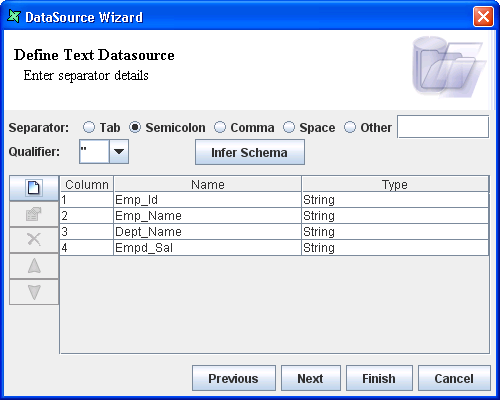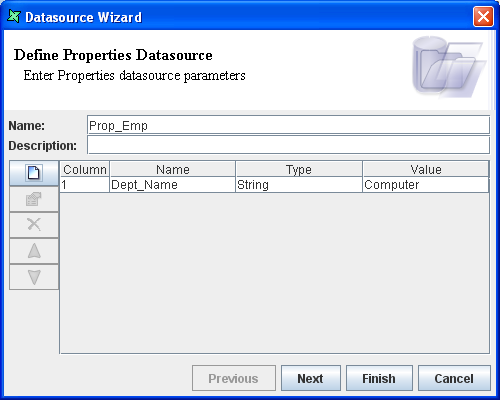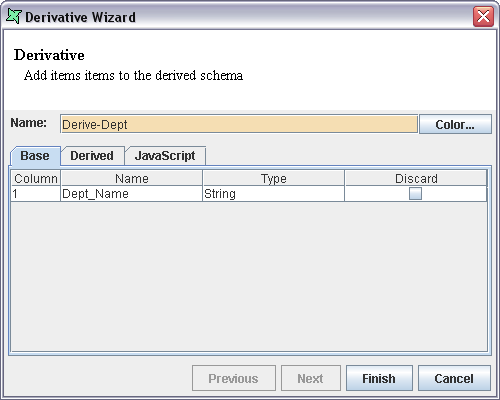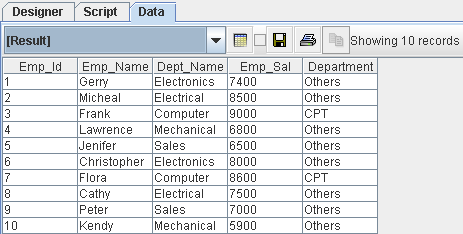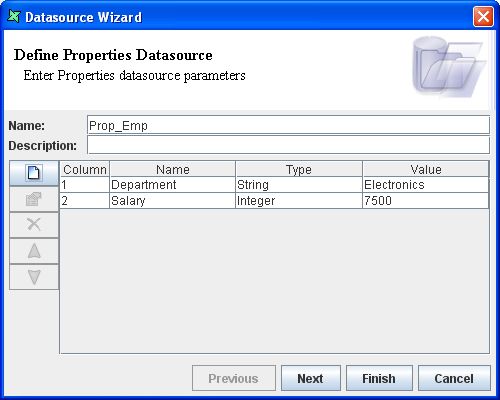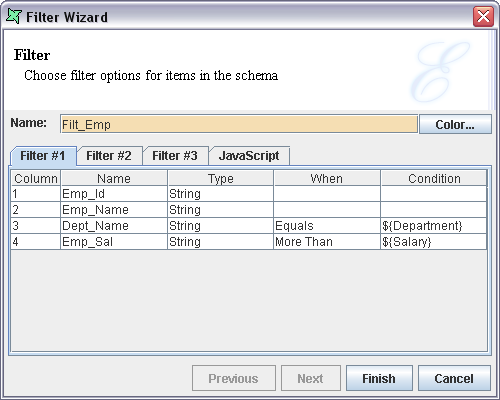The Properties DataSource can be used directly or indirectly through a parameter processor. The following examples illustrate the direct use of Properties DataSource.
The Employee details are maintained in a text file which includes the department field of the employees. Use the following process to derive a new column using the department field of the text data source and check the validity of the derived column using the Properties DataSource:
Use the filesystem or folder popup menu to select Add -> DataSource.
The DataSource Wizard appears.
Select
Text DataSourceand click Next. In the screen that appears, enter a unique name for the data source, such asEmployee.Enter the URL (file path) in the text box or click the browse button to the right of the text box and select the
EmpInfo.txtfile from the Open dialog window.Select the
First line is headeroption.Select the Qualifier as
"and separator asSemicolon. Click Infer Schema to infer the columns. After setting the properties, the screen appears as shown in Figure 8.3, “Text DataSource Parameters”.Click Finish to add the text data source to the repository.Select the same location, and use the popup menu to select Add -> DataSource.
The DataSource Wizard appears. Select Properties DataSource and click Next.
Enter a unique name such as
Prop_Emp.Click Add Column to invoke the
Add Columndialog window. Enter the column name asDept_Name(same column name as in the text data source), Data type asStringand the value asComputer. After entering the values, theAdd Columndialog appears.Click Ok to add the column to the Wizard. The screen appears as shown in Figure 8.4, “Properties DataSource”.
Click Finish to add the
Prop_Empdata source to the repository.Select
Properties Samp, and use the popup menu to add a Composite DataSource calledComp1.Double click the
Comp1.dsdata source to open the composite designer window.Select and place the properties data source
Prop_Empon the diagram. Select the derivative processor from the Action bar of the designer window and place it on the diagram.Connect the output of
Prop_Empto the input of the Derivative processor.Open the Derivative Properties and select the Derived tab. Click Add Column.
In the
Add Columndialog, enter the name asDepartment, data type asStringand the value asdept. Click Ok to add the column to the wizard. After entering the properties, the processor window appears as shown in Figure 8.5, “Derivative Wizard”.Select the JavaScript tab and enter the following script in the window.
if (Dept_Name== "Computer") dept = "CPT"; else dept = "Others";
Click Finish.
Connect the output of the
Derive-Deptprocessor to the Result. Select Result and choose View from the popup menu. The output will be displayed in the data window as shown in Figure 8.6, “Test Output”. Notice that the department Computer is mapped to CPT.Now delete the flow between the
Prop_Empdata source and theDerive-Deptprocessor.Select and place the
Employee.dsdata source in the designer window. Using the flow processor, connect the output of theEmployee.dsdata source to the input of theDerive-Deptprocessor. Select Result, and choose View from the popup menu. The output will be displayed in the data window as shown in Figure 8.7, “Full Output”. Notice that all the records containing the Computer department are mapped to "CPT", and the Other departments are mapped to others. The above procedure makes it easy to check the validity of the derived columns.Note
Therefore, if you want to test a flow with specific values, you can use a Properties data source to provide them, then switch back to the real data source for release.
The following procedure illustrates how to use a Properties DataSource along with the Parameter processor, to pass parameter values to check a Filter condition:
Add a Properties DataSource named
Prop_Emp1.Add a column called
Departmentwith data typeStringand valueElectronics.Add a column called
Salarywith data typeIntegerand value7500. The values are shown in Figure 8.8, “Prop_Emp1”.Click Finish to add the data source to the repository.
Add a Composite DataSource called
Comp2.Open the Composite diagram and and drag the
Employee.dsfile onto it. Add a Filter processor to the diagram as well.Connect the output of the Employee DataSource to the input of the Filter processor.
Open the filter properties. In the row corresponding to the
Dept_Namefield, select the Equals option from the combo box of theWhencolumn. Enter the condition as${Department}.In the row corresponding to the
Emp_Salfield, select the More Than option from the combo box of theWhencolumn. Enter the condition as${Salary}. After entering the values, the page appears as shown in Figure 8.9, “Filter Wizard”. Click Finish.Select the Parameters processor from the action bar and place it in the workspace of the designer window. Change the colour of the processor.
Connect the output of the Filter processor to the input of the Parameters processor
Select and place the
Prop_Emp1data source in the designer window workspace.Connect the
Prop_Emp1DataSource with the params input of the Parameters processor. Also, connect the output of the Parameters processor to the Result.Select Result, and choose View from the popup menu. The output is displayed as shown in Figure 8.10, “Output”.
The values passed by the records of the
Prop_Emp1data source are matched with the dynamic parameters in the filter condition. Based on this, the records of the text data source satisfying the filter condition are fetched.
As the flows are pull-push, the data store pulls data from the source, and this is when the parameters get added. The pull command propagates back to the filter which uses the properties to control the filter process. The pull command terminates at the datasource, which pushes the data back along the flow, through the filter which has already been configured.
